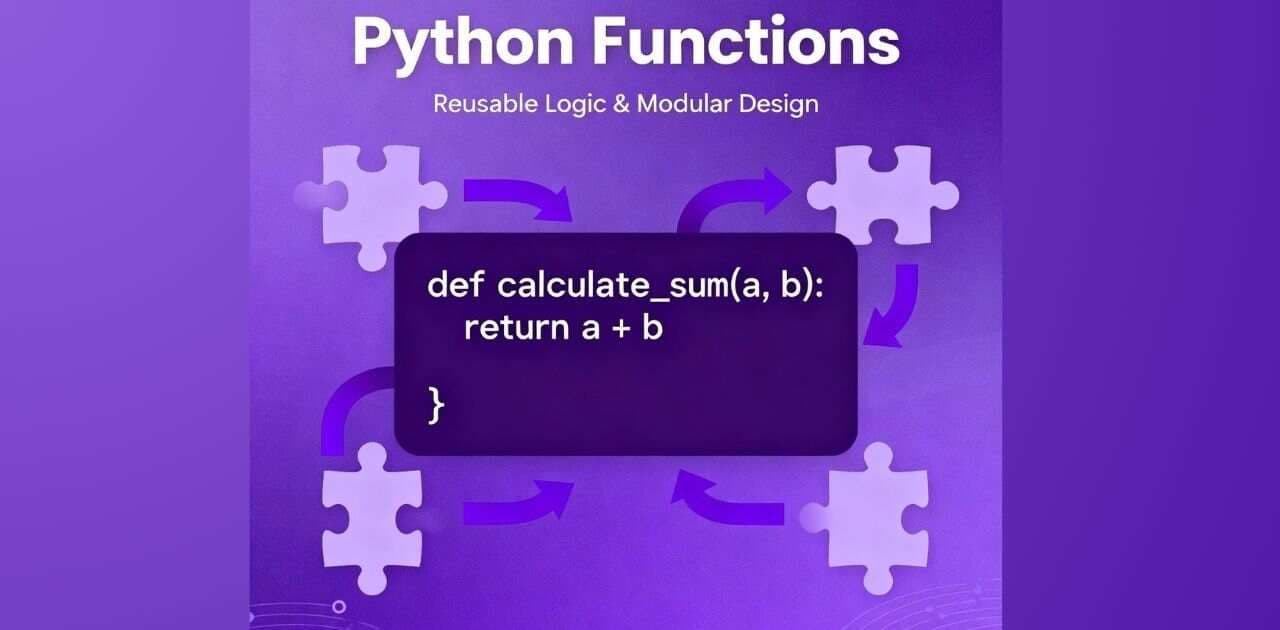
Introduction
Building maintainable, scalable software often means tackling complexity head-on—and functions in Python are the secret weapon programmers rely on to tame that complexity. If you’ve journeyed through our earlier posts in the Mastering Python series, you’re comfortable with variables, data types, and control flow. Now, it’s time to level up: learning to group related instructions into reusable blocks that make your code neater, smarter, and far easier to debug.
So what’s the big deal about functions? In Python—and most programming languages—functions are foundational. They organize logic, reduce repetition, and allow you to write code once, then use it as many times as needed. By mastering Python functions, you’ll be able to build not just scripts, but components for robust applications that scale gracefully.
This tutorial will guide you from understanding what a function is to writing advanced, efficient utilities. You’ll learn:
- How and why functions foster code reuse and modularity.
- The nuts and bolts of defining, calling, and documenting functions.
- Best practices for writing readable, discoverable blocks for collaboration.
- Working with parameters, arguments, return values, and even recursive logic.
- Using lambda functions for quick, one-off operations.
- Real-world scenarios where modular Python code shines.
By the end, you’ll see why every professional developer treats functions as the bedrock of clean Python—unlocking projects that are easier to develop and scale. Let’s dive deep, step by step, into Python’s approach to modular programming.
Why Functions Matter
Functions are the backbone of modular programming in Python—breaking tasks into smaller pieces that are easier to manage, debug, and test. Organizing your code into blocks helps you:
- Reduce repetition and redundancy.
- Improve readability and maintainability.
- Make debugging quicker by isolating problems in independent components.
Imagine you’re building a script to process data and repeatedly calculate the average of several lists. Without functions:
Function-Based Refactor
But with a function:
Now, logic lives in one place. To change how “average” is calculated, tweak the function once—not everywhere you use it. This makes maintenance faster and avoids errors caused by missed changes.
Benefits in Practice
- Reusability: Write once, call anywhere in the script or other modules.
- Testing: Functions can be tested separately for correctness.
- Teamwork: Groups can collaborate on functional “chunks,” merging code more easily.
- Debugging: If something breaks, you inspect the function code—no need to sift through unrelated logic.
Functions deliver cleaner architecture and professional results, whether for small scripts or enterprise-grade applications.
Defining and Calling Functions
What is a function in Python? It’s a block of code with a name, parameters (optional), and a body that does the work only when called. Here’s how you build your first:
Anatomy of a Function
Best Practices
- Naming: Use descriptive, lowercase names (e.g.,
calculate_area). - Docstrings: Document functions with triple quotes for clarity.
- Comments: Supplement with inline comments only when non-obvious logic is present.
Calling Functions
To run a function, simply call it by name and provide arguments if needed.
Positional, Keyword, and Default Arguments
- Positional Arguments: Passed in order.
- Keyword Arguments: Specify parameter names.
- Default Arguments: Provide fallback values.
Variable-Length Arguments
Python supports variable-length (or “variadic”) arguments:
*argsfor positional groups.**kwargsfor keyword groups.
Use these features to capture dynamic input, creating highly flexible code.
Parameters, Arguments, and Return Values
Parameters are names for the data your function expects, set in parentheses. Arguments are the actual values supplied when calling the function.
Passing Data
Returning Data
A function can:
- Return a single value (number, string, etc.).
- Return multiple values, typically as a tuple.
You can also return more complex types—lists, dictionaries, custom objects.
Mutability and Side Effects
When passing mutable types (like lists, dictionaries), changes inside the function affect the original data.
Immutable types (int, float, str, tuple) do not change outside the function.
Visual Analogy: The Call Stack
Imagine a call stack as a stack of plates:
- Each time you call a function, a new plate is added to the stack.
- When a function finishes (returns), its plate is removed.
- Variables exist only on their plate: once removed, those variables disappear.
This analogy helps explain how Python keeps track of active functions, local variable scope, and return flow. Diagramming or visualizing this idea helps clarify control flow for beginners.
Scope and Lifetime of Variables
Function variables in Python have scope—where they’re accessible—and lifetime—how long they exist.
Local vs. Global Scope
- Local variables: Defined inside functions, exist only during that function’s execution.
- Global variables: Defined outside any function, accessible anywhere.
The global and nonlocal Keywords
- Use
globalwhen your function needs to modify a variable outside its scope:
- Use
nonlocalfor nested functions to modify variables in the nearest enclosing scope (but not global):
Common Pitfalls
- Shadowing: Using the same variable name inside and outside a function can cause confusion.
- Forgetting scope: If you try to access or modify a local variable outside its function, Python throws an error.
Debugging Tips
- Print variable types and values to understand scope issues.
- Check indentation—misplaced code blocks can accidentally move logic out of function scope.
- Prefer local scope for temporary variables. Only use global variables for truly shared data.
Recursion – A Gentle Introduction
Recursion in Python is when a function calls itself to solve a problem by breaking it down into smaller instances.
What is Recursion?
It’s great for tasks like calculating factorials, traversing trees, or solving problems broken into identical subproblems.
Example: Factorial
Example: Fibonacci
Base Case
Every recursive function needs a base case—when to stop calling itself. Without a base case, recursion runs forever (causing stack overflow).
When to Use Recursion
- Problems that break into smaller, similar pieces (factorials, tree traversal).
- But, for many cases, loops are more efficient and simpler.
Recursion Depth
Python limits recursion depth (usually to 1000 calls). Too deep recursion causes a RecursionError. For most practical tasks, iterative solutions run faster and use less memory. Use recursion for tasks where it’s a natural fit, and prefer loops elsewhere.
Lambda Functions
Python lambda functions are small, anonymous functions built for “short” tasks, especially inside other functions or methods. The syntax:
Example: Add Two Numbers
Using Lambda with map(), filter(), and sorted()
map(): Transform sequences.filter(): Keep only items that match a condition.sorted(): Sort with a custom key.
Regular Function Comparison
Use regular functions for reusable logic with documentation. Use lambda only for quick, one-off expressions.
Readability Warning
Too much lambda usage leads to code that's harder to understand and debug. Use only where simple logic is enough and documentation isn’t needed.
Real-World Applications
Functions in Python enable building practical, modular solutions for all project types.
Data Processing Utilities
Example: Clean and normalize dataset columns.
String Manipulation
Example: Format greetings for a UI display.
API Request Handling
Example: Encapsulate repetitive request code.
Small Automation Scripts
Example: Rename files or organize directories.
Each utility showcases why modular code saves time, improves clarity, and helps scale solutions to larger problems or teams. Functions let you build reliable blocks that grow into entire projects.
Hands-on Exercises
Build functional skills with these progressive challenges:
- Basic Greeting Function
Write a functiongreet_user(username)that prints a personalized greeting.
Hint: Useprint()and string formatting. - Word Frequency Counter
Write a functionword_frequency(text)that returns a dictionary of word counts.
Hint: Usesplit(), loops, anddict.get(). - List Filter Function
Write a functionfilter_even(numbers)that returns a new list of even numbers from a provided list.
Hint: Usefilter()with a lambda. - Recursive Sum
Writerecursive_sum(numbers)that returns the sum using recursion.
Hint: Use slicing and a base case. - API Request Wrapper
Write a functionget_weather(city)making a web request to a weather API and returning parsed temperature.
Hint: Userequests.get()and check JSON data.
Partial solutions or hints can guide learners, focusing on breaking large tasks into manageable, testable steps. This process cements the value of modular coding firsthand.
Conclusion
Functions in Python are the essential bridge to writing modular, reusable, and organized code. By mastering functional design principles now, you build a foundation for future skills: handling large projects, collaborating effectively, and troubleshooting complex bugs faster.
The next post in this Mastering Python series will tackle even more advanced concepts—like creating custom modules and starting with object-oriented programming. For now, keep experimenting: turn repetitive tasks into functions and try solving bigger problems by composing small blocks together.
Outside of coding, this modular mindset applies everywhere: break big tasks into smaller steps, test each piece, and grow your expertise. Happy coding—and welcome to the next phase of your Python journey!
FAQs
What is a function in Python?
A function is a named block of code that performs a specific task and can be reused across a program for modularity and efficiency.
How do you return multiple values in Python?
By separating values with commas in the return statement; Python creates a tuple.
What’s the difference between arguments and parameters?
Parameters are variable names in the function definition; arguments are actual data passed when calling the function.
What are lambda functions used for?
Lambda functions (anonymous functions) are used for short, throwaway operations, often where concise syntax is preferred (like with map or filter).
How does scope affect variables in Python functions?
Variables defined inside functions are local; those outside are global. Use global and nonlocal keywords to modify scope as needed.

